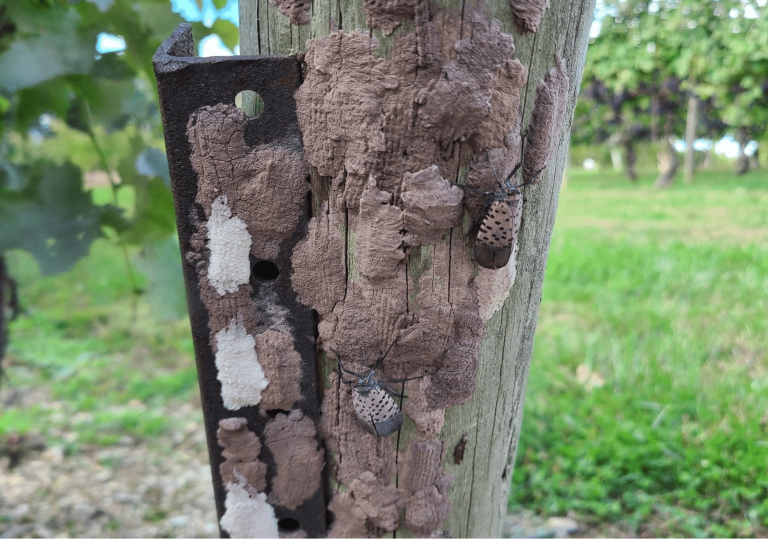
By Hildur Palsdottir
Remember that alien-looking bug from last summer, Spotted Lanternfly (Lycorma delicatula)? It looks a bit like a big, colorful moth or a small, chubby butterfly. At the end of last summer the Spotted Lanternfly crowded trunks of various hardwoods and grapevines.
This infestation is nasty looking, even to people like me who love bugs. They excrete honeydew that leaves a sticky mess and may cause the growth of black sooty mold.
SLF are native to China, India, and Vietnam, and were first sighted in 2014 in Berks County, Pennsylvania.
It is speculated that they were brought to the United States with imported goods. SLF can only travel short distances. But this planthopper can hitchhike by laying eggs on flat surfaces.
Sadly, we’re expecting an even more obnoxious SLF invasion this summer compared to last year. Our best hope right now is to get all hands on deck this spring to remove egg masses wherever you find them. Yes, this year’s egg hunt must last all spring. Or else, we can prepare for unmanageable swarms of them.
Please look for brownish-gray egg masses. These egg masses are about an inch long. The eggs themselves are much smaller. The female SLF secretes a white, waxy substance over the eggs that looks glossy at first and is mud-like.
When it ages it dries to a grey-brown cover that fades and cracks. Old egg masses are scaly looking and in the end eggs are exposed.
Now is the perfect time to look under your patio furniture, vehicles, firewood, and inspect tree trunks.
Carefully examine all flat and semi-flat surfaces for these egg masses. If you do find the eggs you can scrape them off with a credit card or a hard tool and place them in a closed container with rubbing alcohol or hand sanitizer.
You’ll be rewarded for the time you spend hunting for SLF eggs. Your tax dollars may otherwise be spent on fighting this form of biological pollution.
It’s worth the effort to familiarize yourself with how to control and manage this invasive insect.
In a 2011 testimony to the state Assembly about the threat of invasives to New York ecosystems and economy, DEC Assistant Commissioner Christopher Amato warned that the economic losses associated with invasives in the United States are estimated at 120 billion dollars per year.
The control and management of invasives is expensive and SLF infestation can easily cost New York state millions of dollars. Here on Long Island our crops and vineyards are at risk. Also, keep in mind that being swarmed by these bugs can easily ruin a perfect beach day.
It is therefore well worth your effort to go outside and look for egg masses. Now is our chance to curb the spread. Once they emerge, the task becomes much harder.
Since it is less expensive and easier to deal with a problem before it becomes widespread, our priority has to be to find and treat SLF infestations early.
The changes to our ecosystems are happening too fast for experts and scientists to keep up with them. We all need to become citizen scientists and help document the spread of invasives. If you’re tech savvy you can help tremendously by downloading iMapInvasives on your smartphone or computer where you can adopt a square to document the presence or absence of SLF and other invasives.
If NYiMapInvasive is not for you, try iNaturalist, a simpler mobile application to enhance your ecoliteracy, this app also works on desktops. By recording your findings with iNaturalists you are helping scientists understand the changes in composition of flora and fauna that are happening rapidly now in response to a changing climate.
Long Island Invasive Species Management Areaare committed to informing the public and curbing the spread of invasives. They’re one of 8 Partnerships for Regional Invasive Species Management (PRISMs) across New York State dedicated to preventing or minimizing the harm caused by invasive species.
The PRISMs collaborate with the state Department of Environmental Conservation (DEC), resource managers, non-governmental organizations, landscapers, industry and other agencies to fight invasives.
Locally, you can contact Cornell Cooperative Extension, Nassau (CCE-N) for diagnostics and guidance. You can send your collected specimens to CCE-N to confirm identification and receive guidance on how to treat infestation. Find out more here https://ccenassau.org/horticulture/plant-diagnostics-soil-health-center.
For management decisions the PRISMs created a tier system. You can look up your invasive plant or animal of interest to see where it falls with regard to manageability. Early detection goes with fast removal, so invasives that fall in Tier 1 can be eradicated. Tier 2 is more difficult to remove, but can be done. Tier 3 and 4 are too widespread for eradication, but can be contained and managed if addressed properly.
The downside of increased trade and travel is the spread of invasives. Especially the horticulture trade must be scrutinized to prevent the spread of pests and diseases. We need better regulation and oversight in all states, not just New York.
New York’s biodiversity is threatened by human activity, invasives and climate change, all of which amplify each other’s destructiveness. Invasive plants and pests can be viewed as a form of biological pollution and humans are to blame for their introduction and spread.
We must now do what we can to inform each other and our regulatory agencies to mitigate the harm done and prevent the spread of invasives.








Here’s a good link for pictures of egg masses https://extension.psu.edu/what-should-you-do-with-spotted-lanternfly-egg-masses#:~:text=Often%2C%20the%20hosts%20preferred%20by,black%20cherry%20and%20pine%20trees